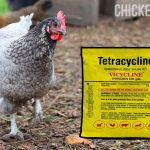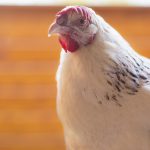Fowlpox in Chickens: Causes & Treatment
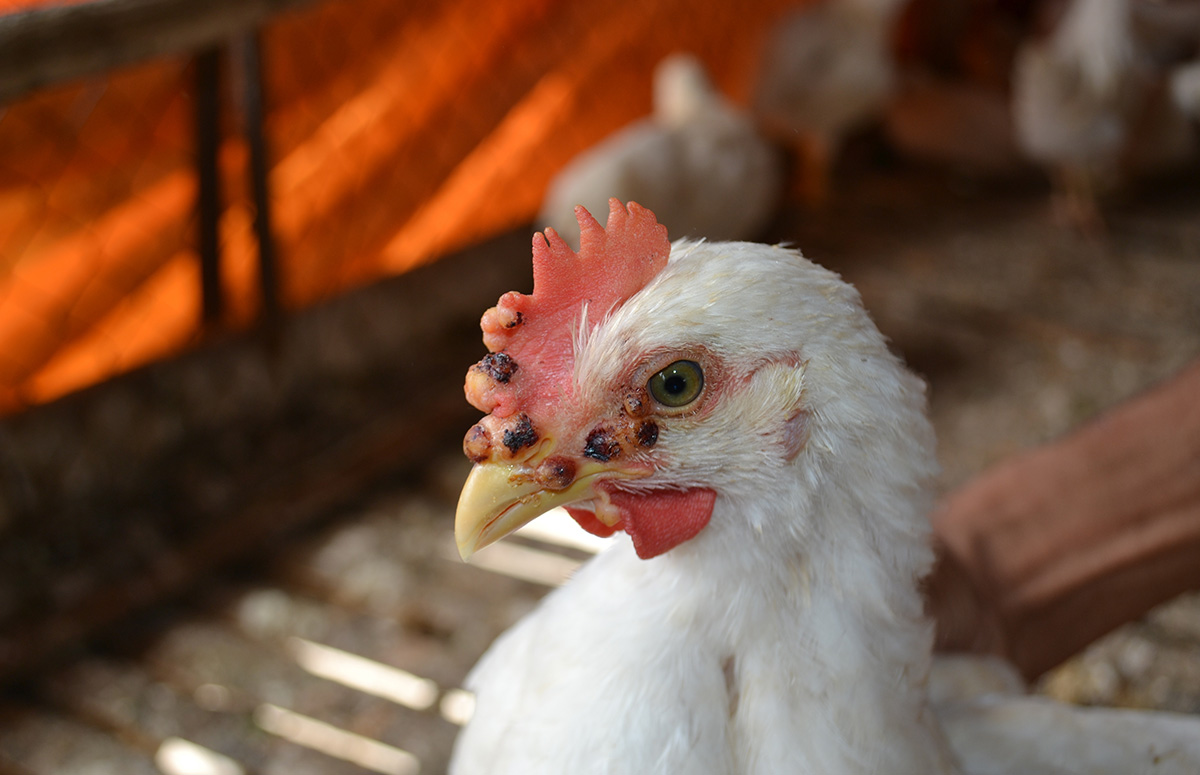

Chicken Fans is reader-supported. When you buy through our links, we may earn a commission. Learn more about our privacy policy and disclaimer.
Fowlpox is a slow-spreading infection that can torment a backyard chicken flock for many months. Although not contagious for humans, it can be dangerous for chickens. Since there is no cure yet, chicken owners should inform themselves.
We’ll take you through everything there is to know about fowlpox in chickens.
What is Fowlpox?
Fowlpox is a severe skin infection in poultry caused by the avian pox virus.
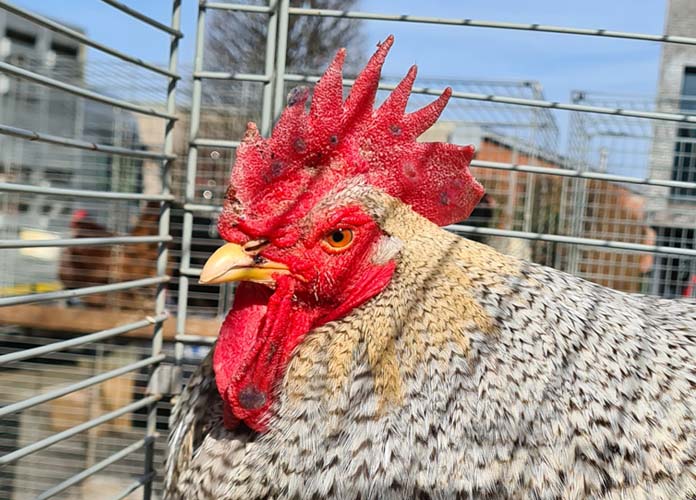
Fowlpox comes in two forms:
- Dry Pox: known for its black spots on a chicken’s comb and other unfeathered areas (cutaneous form)
- Wet Pox: known for its yellowish plaques in the mouth (diphtheritic form)
The most common form is dry pox, transmitted by mosquito bites or skin contact. It creates painful blisters and warts on the chicken’s unfeathered skin parts, like the comb, eyes, and legs.
Wet pox is caused by inhalation or ingestion of the virus. It affects a chicken’s mouth, throat, esophagus, and respiratory system. The lesions in the mouth and gullet hamper swallowing. The lesions in the respiratory system hinder breathing.
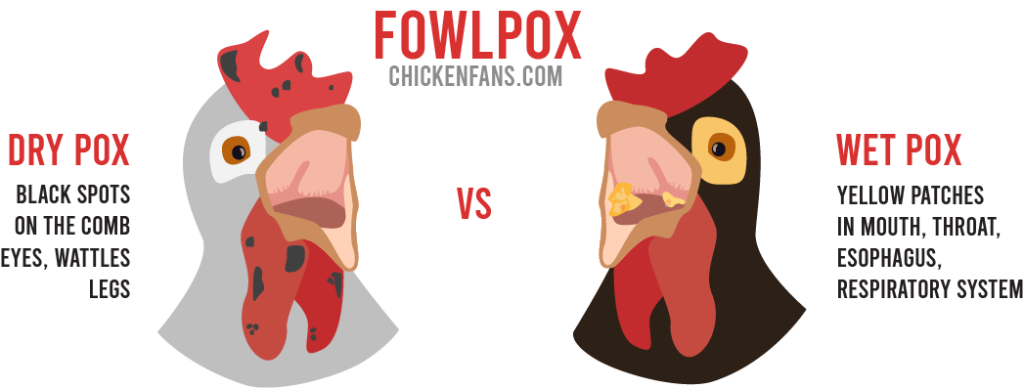
The wet pox form is the more deadly, as the yellow plaques in the throat and gastrointestinal tract can grow so immense that the chicken can’t eat or drink anymore.
Infected hens will suffer from one or both forms at the same time. Most birds recover, but fowlpox can have an economic impact as it causes reduced egg production.
Luckily, this virus differs from human chickenpox and can’t infect people.
Dry Pox
The dry cutaneous form of fowlpox is known for the black pimples and scabs growing on the chicken’s skin. These nodules are mainly visible on the unfeathered parts of the chicken, such as the comb, eyes, wattles, and legs. They start as pimples, turn yellow, and become thick, dark scabs.
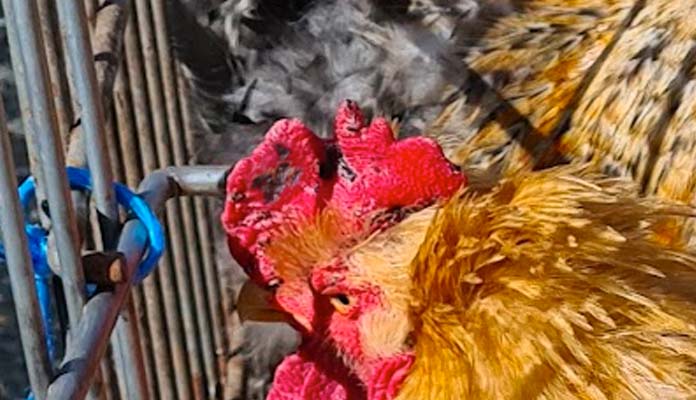
The eyelid can grow completely closed when the virus manifests near the eye. The scabs are painful and cause a fair amount of discomfort for the chicken.
While they are hopping around with the pox scabs, their skin is prone to secondary infections. Keeping them clean is crucial to prevent further damage.
The scabs last for two to four weeks. Then they come off and fall on the ground, leaving a scar on the chicken’s skin. The fluttering pox scabs are highly infectious to the other chickens.
Noticing some black spots on a chicken’s comb doesn’t always mean you are dealing with a dry pox infection in your flock. Usually, black spots are just peck marks. We composed a long list of causes for black spots on a chicken’s comb.
Wet Pox
The wet, diphtheritic form of fowlpox does not manifest on the outer skin but in the upper gastrointestinal and respiratory tract. It causes a yellowish plaque in the chicken’s mouth, throat, windpipe, and esophagus.
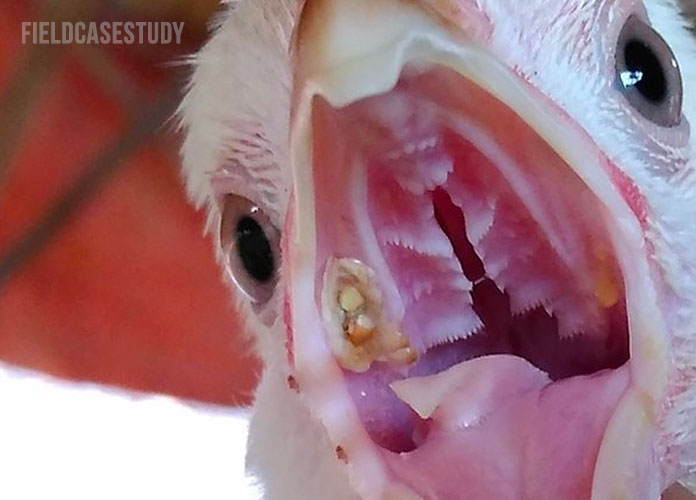
The plaque starts with small white spots, turning yellow and growing into large patches. They can grow so large that the chicken can’t swallow anymore. Chickens can have difficulty breathing and yawn with an open beak.
Usually, a chicken catches either the dry or the wet variant, but they can occur together. Both forms can coincide when there is a pox infection in the flock.
How to Treat Fowlpox
There is no specific cure for chickens infected with fowlpox. Isolate the birds and provide supportive care while you let the virus run its course. Clean and disinfect the scabs as much as possible to prevent secondary infections.
Several over-the-counter products are available to treat the black spots on the combs and wattles of dry fowlpox.
- Remove dirt and loose skin but don’t force off the pox scabs. Keep black spots on the comb, wattles, and other infected areas clean and dry.
- Use MicrocynAH and antiseptic wipes to clean and disinfect the area 3-4 times daily. Remove excess feathers and clip if necessary. You can also use iodine washes such as Lugol’s as an antimicrobial treatment.
- Vitamin A supplementation can be given as adjunctive therapy to boost the immune response: 2000IU/kg or in total 10.000IU daily. Vitamin A is recommended in heat stress situations.
- Only supportive treatment is possible for dry fowl pox: you have to let it run its course. Eliminate standing water and prevent mosquitos, insect bites and fighting.
Vitamin A is an adjunctive treatment for avian pox to boost the immune system. Vitamin A for pox infections is most effective in case of deficiencies or when chickens suffer from (heat) stress.
Additionally, vitamins B and C can also be included in their diet as a supportive treatment to boost the chickens’ immune system and as an anti-stress supplement.
Keep the environment as clean as possible to prevent the further spreading of the virus:
- isolate the infected birds and put them in quarantine
- decontaminate and clean the full chicken coop, their feeders, waterers, and perches
- avoid dragging the virus in with your clothes, shoes, or other equipment
Some vets will prescribe antibiotics to prevent secondary infections, but antibiotics will not help against the pox virus itself.
Transmission of Fowlpox
Fowlpox can infect the birds of a flock at any age. It’s in no way comparable with chickenpox infections that usually occur in young children.
Flock infection
Most flock infections start with mosquito bites. When a mosquito feeds on the blood of an infected bird, it can carry the virus around for about two months. If the mosquito bites any of your chickens during that time, it can infect the bird with the pox virus. A single mosquito can infect multiple chickens and multiple flocks.
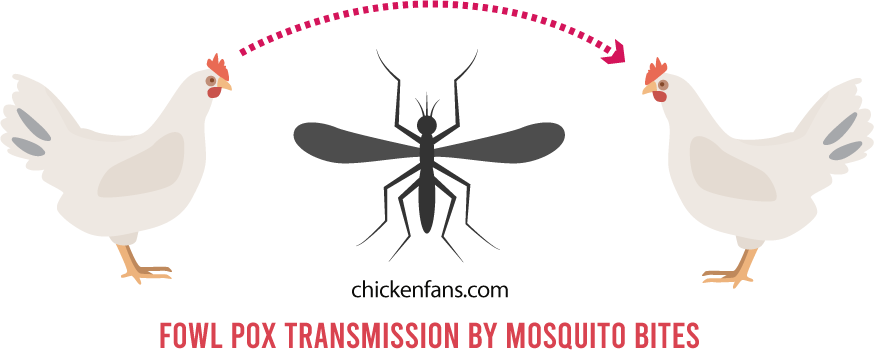
The virus incubation period is four to ten days, and nodules start to show up about five to eight days after the infection.
Spread inside the flock
Once the virus has entered the flock, it slowly spreads through the flock in different ways.
The virus is often transmitted by skin contact or chickens pecking each other. The scabs look like tiny insects and attract other chickens’ attention.
Dried scabs and broken skin that fall off still contain the pox virus and are highly infectious. Another bird can pick up the virus by scratching and pecking in the dirt. Additionally, the disease can be transferred through their mucus membranes.
To make matters worse, the virus is highly resistant and can survive up to a year in a dried scab flying around in the soil. When the virus enters your premises, it may take several months to get rid of it.
Dried skin sheds and scabs crumble over time, and small virus particles can be carried around in aerosols floating through the air. The pox virus is airborne and can infect chickens that inhale the virus particles. This can result in an infection with wet pox when the virus particles attach to the throat.
On the positive side, chickens recovered from fowl pox are no longer contagious. They can’t infect other chickens.
Can Humans Get Fowlpox?
No, fowlpox is not contagious to humans. Fowlpox is an avian pox virus that is very host-specific and can only replicate in avian cells. There is currently no scientific evidence that it can infect humans. Since the virus is so safe, it’s even used in vaccine development for human diseases.
This is rather remarkable, as avian pox is in the same virus family as human smallpox. The smallpox virus killed up to 300 million people in the 20th century. It was only eradicated in 1980 after a worldwide vaccination campaign.
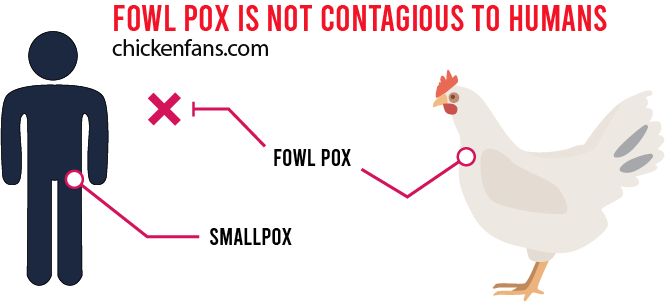
This raises some questions. Since avian pox is so contagious for chickens, why can’t a mutation jump on a human if it’s in the same family as smallpox?
Although being investigated by scientists for vaccine development, the replication mechanisms of the avian pox virus are poorly understood compared to other poxviruses. The infection of a cell is a complex process. The virus first needs to overcome multiple body and immune system defense mechanisms. After intrusion, the fowlpox virus must learn how to build proteins based on its viral DNA.
Fowlpox viruses cannot do that in human cells or other mammals, but they certainly can in chickens and turkeys.
How to Prevent Fowlpox
The best way to prevent infection and spread is to vaccinate your chickens. There are several effective vaccines on the market. Most of the available vaccines are attenuated live vaccines. They contain the real germ but in a weakened form.
Some vaccines are not attenuated but applied in a body location where the pox can’t occur. Improper vaccination with these vaccines can cause infections.
Chicks can be vaccinated after hatching and re-vaccinated when they are 12-16 weeks old. Vaccinated chicks should have permanent immunity. In high-risk areas, vaccination of adult birds can be repeated yearly before the mosquitos show up in summer. If less than 20% of the flock is infected, you can vaccinate the other birds of the flock as a preventative measure.
It’s impossible to prevent fowlpox just by regular maintenance and proper hygiene. But in case of an infection, you should isolate the infected chickens and prevent further spreading by applying proper bio-security.
The only thing you can do is to try to keep the mosquitos out:
- avoid stagnant water like small backyard ponds
- install mosquito traps near the chicken coop
- install mosquito mesh netting
- use insecticidal spray around the chicken coop
- plant mosquito-repelling vegetation and herbs like eucalyptus, lemongrass, or peppermint
But as we all know, mosquitoes are very persistent and difficult to keep out.
Never install mosquito repellents based on diffusers in the chicken coop. Most of them evaporate toxic pesticides that can harm your chickens when they inhale the fumes.
Fowlpox as Pox Virus
Reading articles about the fowlpox virus can be very confusing, as there are so many names and strains.
Let’s shed some light and see how they all relate together.
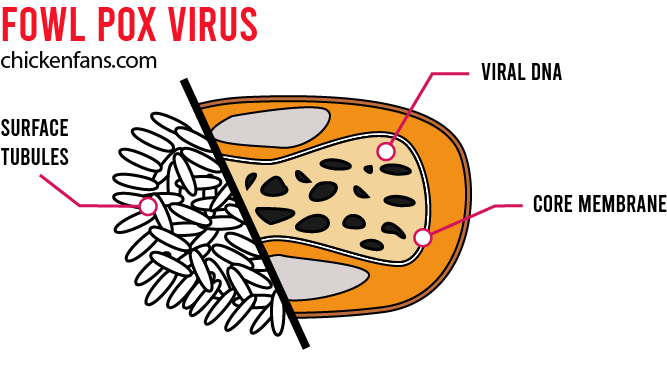
Difference between Fowlpox, Canarypox, and Pigeonpox
Fowlpox is a specific variety of the avian pox virus to which only poultry is susceptible. Fowlpox will only manifest in chickens and turkeys.
There are other types of avian pox virus that target different birds. Pigeonpox only affects pigeons, canarypox only affects canaries, and quailpox only affects quails. Apart from these, there exist several other variations. All these avian poxviruses are different, and each virus can only grow and replicate on a particular host.
The fascinating part is that they share the same antigens. Antigens are markers of the virus that the immune system recognizes. Strains of canarypox can be used to train the immune system of other birds. The immune system will create antibodies without the risk of getting sick.
Difference between Fowlpox, Chickenpox, and Smallpox
Fowlpox is an avian pox that targets chickens. Avian pox in itself is part of an even larger family of poxviruses, including smallpox. Smallpox killed up to 300 million people in the 20th century.
After a worldwide vaccination initiative of the WHO, smallpox became the first infectious disease that has completely been eradicated from our planet in 1980. The second one was rinderpest in 2011.
Smallpox was a terrible disease, and the malignant version was almost always fatal. It could kill a human in 8 days. The symptoms are the same as with all poxviruses. People develop painful skin rashes all over their bodies that turn into fluid-filled blisters.
Chickenpox is something completely different.
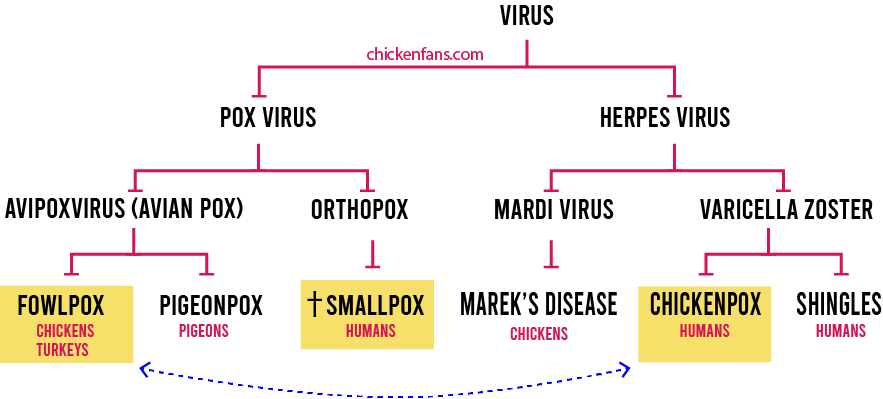
Chickenpox
Chickenpox is a disease caused by the varicella-zoster virus, a common herpes virus. It’s also highly contagious but has nothing to do with poxviruses.
When smallpox was still around, there was a lot of confusion when people got infected, as chickenpox also causes small itchy blisters all over the body.
Chickenpox has nothing to do with chickens, and your chickens can’t get infected.
There are a lot of theories on how chickenpox got its name. One theory is that the blisters of chickenpox look like peck marks caused by chickens. Another theory is that it refers to the mildness of the disease compared to smallpox.
Marek’s disease
While varicella-zoster is a herpes virus targeting humans, there is an equivalent herpes virus that actually targets chickens. It causes Marek’s disease and shares many biochemical characteristics with chickenpox.
Marek’s disease is a widespread, horrible, cancerous disease that paralyzes chickens. Most chickens are vaccinated against Marek’s, but in 2020, some virulent strains could break through the vaccines. Read our full in-depth explanation of Marek’s disease to learn more about this horrible disease and its risks.
Conclusion
Fowlpox is a highly contagious virus that infects chickens. It is usually brought to the flock by mosquitoes, and there is no cure yet. The best way to prevent an outbreak is to vaccinate your chickens. You can treat chickens with fowlpox by providing supportive care and keeping the black scabs clean to prevent further damage.
The fowlpox virus can not infect humans and has nothing to do with chickenpox. Although fowlpox has similarities with other avian poxviruses, it will only affect chickens and turkeys.

Dr. I. Crnec is a licensed veterinarian with several years of experience. She has published work on the effect of vitamin supplementation, egg-laying performances of chickens under heat-stress conditions and the effects of calcium supplementation on eggshell strength.








